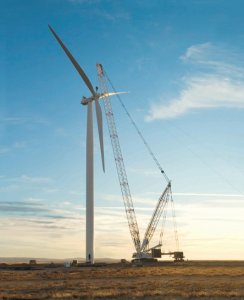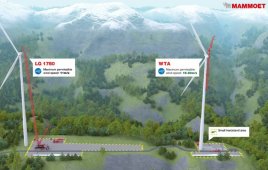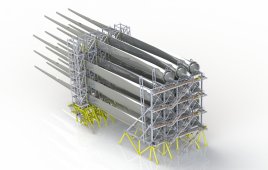
Liebherr crawler crane LR 1300 with derrick equipment and ballast wagon erecting wind turbines in Portland, USA. Therefore, the LR 1300 is equipped with a 98 m main boom. In this configuration it is able to reach load capacities of 68.5 t at a lifting hight of 99.9 m.
Crane manufacturer Liebherr offers the 300-metric ton LR 1300 crawler crane. The German company developed a heavy-duty jib for the crane, especially for assembly and maintenance work on wind power installations. For this area of application the crane can be equipped with a narrow telescopic undercarriage for cost-effective travel movements when space on the ground is limited.
The LR 1300 is powered by a 450-kW (612 hp) diesel engine. It has two winches, each rated at 15 t line pull, with high rope speeds for this rating. Even if multiple reeving is in use, fast lifting speeds and high lifting capacities therefore remain available. As an option, 15 t free-fall winches with multi-disc brakes can be specified.
The jib is 8 m long and rated for a maximum lifting capacity of 117 metric tons. Its full performance potential is revealed when it is used in conjunction with long booms and derrick equipment. The maximum possible combination of 113 m main boom and 8 m heavy duty jib results in a sheave height of 123 m. Even this maximum configuration can handle loads of up to 42 t. With the more customary configuration of 80 m main boom and jib the LR 1300 is able to lift more than 80 t, with a sheave height of almost 90 m.
The standard travel width of the LR 1300 is 8 m, but the undercarriage can be closed up until its width is only 4.8 m. The track width adjustment permits crane travel movements with all equipment installed, including the boom/jib and the complete counterweight. As a result, the LR 1300 is unusually mobile for a machine in this lifting capacity class.
The company says among the LR 1300 SX’s advantages are the big range of multifunctional boom/jib systems with exceptional performance data that can be obtained for it. The combined length of main boom and luffing jib can be as much as 172 m. The high reach boom version permits the main boom to be up to 120 m in length. Especially the new SX-boom offers better lifting capacities because of a stronger boom design as it is required for wind power unit assembly. When heavy loads have to be lifted, a derrick system with wheeled counterweight carriage or suspended counterweight is available. On the “Midfall” equipment version the rope can either be run over the main boom head in the usual way or over an idler pulley with a fixed mounting in the jib.
Within the LR series all boom/jib configurations up to 300 metric tons have been developed for the best possible compatibility. The luffing jibs for the 200 t LR 1200, for example, can also be installed on the LR 1300.

For the erection of wind turbines, Liebherr offers a special undercarriage with narrow track width of only 4.8 m for the erection of wind turbines.
Even for machines of this size, rapid low-cost transportation is an important economic factor. The manufacturer says the crane satisfies this demand with its straightforward, technically advanced self-assembly and self-loading system. Four fold-out support jacks on the undercarriage, an assembly cylinder in the A-frame for unloading and two counterweight hoisting cylinders at the rear of the basic machine mean that a second crane is not needed either to unload the crane or erect it.
After disassembly, the LR 1300 can be carried at reasonable cost on standard low-loaders without exceeding a width of 3 m. Fewer transport vehicles are needed because of the practical way that the jib sections can be inserted into the main boom sections.
The LR 1300’s control system is based on Liebherr’s CANBUS technology. This in-house system has been developed to withstand tough construction-site conditions even when extreme temperatures are encountered. It controls all the operating and monitoring modules, including the new load moment limiter. This device computes lifting capacities automatically during crane operation, to ensure they are optimally utilised. This is the only system concept on the market that does not need memorised load charts or interpolated intermediate values. The user benefits because the crane can be operated more effectively even if construction site conditions occur that call for unusual working radii or crane positions.
A GSM modem is standard equipment on the LR 1300, and provides a data link to the manufacturer’s service point or factory. It transmits machine and process data in a simple, reliable manner and also permits remote online diagnosis to be carried out.
Watch a video of the LR 1300 here
Filed Under: Construction




